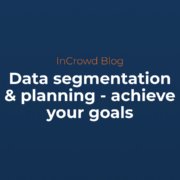Data segmentation & planning – achieve your goals
Everyone is talking a good game about data. Single customer views, segmentation, ROI, buzzword after buzzword and it appears most rights holders and brands know what they want to achieve in this space. However the reality is that the majority are not really set-up to deliver their ambition. I’ve witnessed this time and time again, hearing very forward-thinking audience owners explaining what they are trying to achieve, and then continuing on to admit the struggles they have, or the reality simply not living up to their original ambition. If this story feels familiar, then don’t worry, you’re not alone.
I wanted to share some thoughts on how audience owners can choose a sensible route on the road to successful data strategies and segmented communications. I’ve broken this into five actions.
ONE – Be realistic with your internal capabilities & find efficient solutions.
We could all keep slicing and dicing our data into segments, by age, by gender, by interest, by motivation and so on. But the reality is that each organisation is going to end up with a communication and content plan that suddenly has significantly more stories, emails and posts to create, schedule and distribute; something that clearly requires resource to activate. Does your organisation have people sitting around twiddling their thumbs? I expect not.
The emergence of AI technologies is going to be central to this moving forward, but we will still need to create variations of each content piece. Firstly we need to be realistic with the number segments we create and secondly, look for more efficient means of communication and content creation. This is where short form communication such as mobile push notification is a really attractive route if your organisation or brand has a mobile app. Each identified segment can receive an individual push, with only 10-20 words needing to be written for each, to drive maximum click-through to your promotion/offer.
TWO – Create a commercial plan for your data.
Of course your plans are going to change over time as you begin to have new business goals, or want to / start to work with new partners or advertisers. However, if you can create a data strategy, with a strong base of what you’re trying to achieve, you will be able to ensure your data architecture and tracking is set-up to collect the most commercially useful data. So put simply know what you are collecting, not collecting, and why!

THREE – Understand the channels through which you plan to communicate.
Yes, I’m going to mention GDPR (sorry), but we need to make sure when we are collecting data that we are able to use this data in all the ways in which we want to. It’s time to get the crystal ball out with this one.
FOUR – Don’t segment for segmentation sake.
You need to understand which segments are actually going to drive a different (and useful) response for you and your partners. This is where you might want to bow to the data and research experts, perhaps working with a third party agency to support your data intelligence. Also, using digital/social marketing as a marketing research tool is great here. Running some low-cost digital adverts to different audience sets, and testing against different messaging and images, is a quickfire way to see how different segments respond to your messaging, and whether it’s worth segmenting in this way moving forward.
FIVE – Make sure you have the right information.
Too many audience owners simply don’t have enough depth of data about their customers/fans to truly make a difference through segmentation. Understanding transactional and demographic information is useful. However, understanding what interests, motivates and engages your audience base starts to make things really interesting. Your segmentation will start to make more sense and deliver results.
At InCrowd we have expertise in all of the above. What I find most exciting is where we can help our clients with the fifth action and their key audience – their fans. InCrowd create audience engagement tools, primarily through mobile applications and digital integrations. These help sports organisations and brands gather data about each individual fan. Then, we can support them in developing a strategy to commercialise this data in a way that requires a pretty light amount of resource.
If you’re keen to find out more, visit www.incrowdsports.com
or contact us now – enquiries@incrowdsports.com


